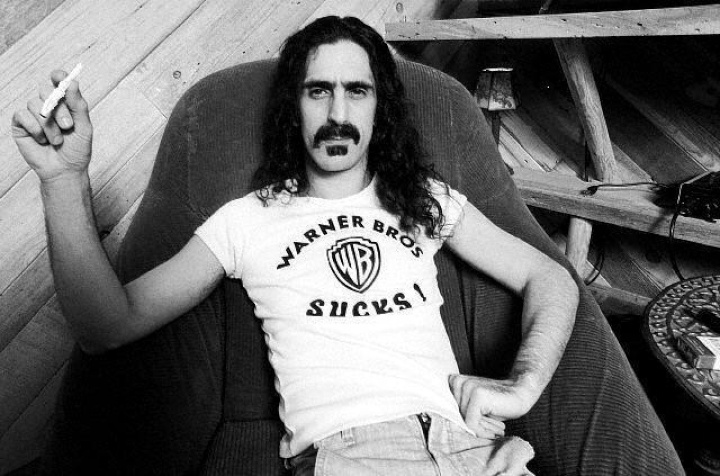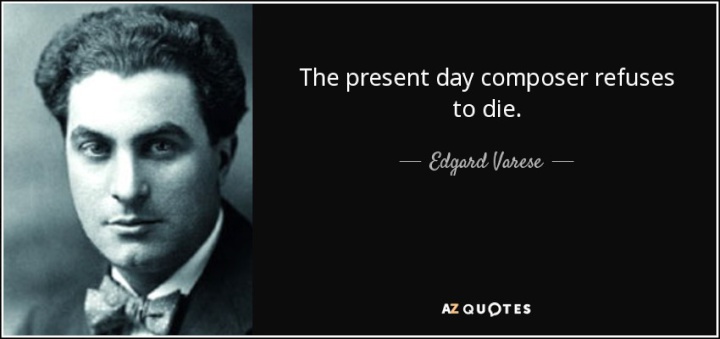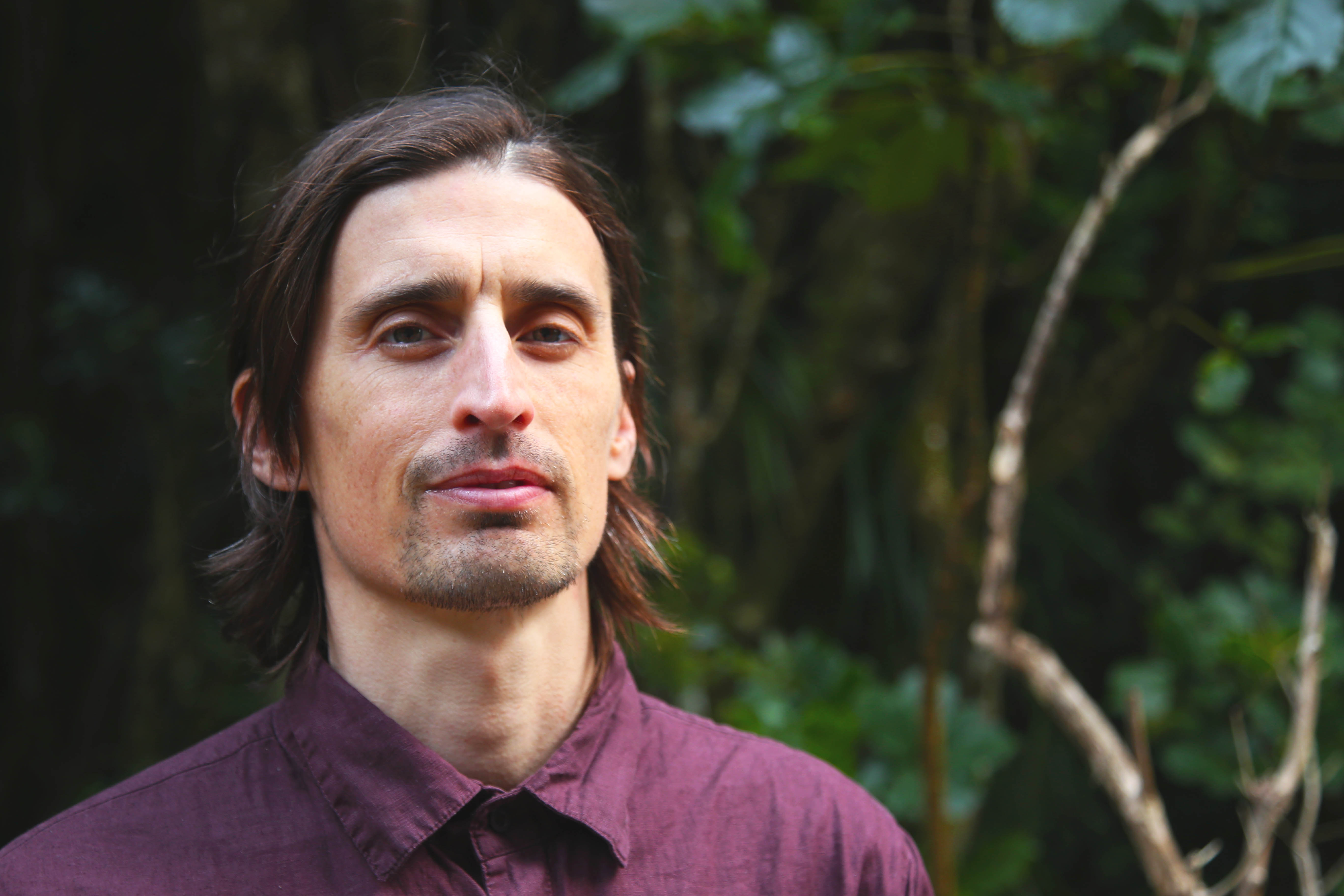
The first of the NZSO’s Shed Series concerts at the more informal and intimate space of Wellington's Shed 6 last Friday night featured music composed by, or with a connection to Frank Zappa. Zappa, a psychedelic rock legend, activist and popular culture figure and all round colourful character, was an excellent choice for the concert’s theme of innovation. This material opened up an interesting angle of classical music composed by or interpreted through the lense of Zappa who was an innovator and in a sense an outsider to the classical music world. All in all this was a great choice for the first in this NZSO concert series seeking to cross boundaries and bring in new audiences.
The NZSO Innovation concept was well thought out and delivered and brought a refreshingly casual atmosphere to the national orchestra’s work. The concert made an excellent use of the Shed 6 space, it was anarchically set up with a smattering of chairs and a few tables that the audience were free arrange themselves, however at least a third of the audience were simply standing at the back of the venue where live drawing was being projected by artist Mick Finn on the side wall of the shed and they could purchase drinks from a nearby bar. There was certainly a diverse mix of zappa fans and the regular NZSO crowd making for a less formal, yet highly appreciative atmosphere.
Who is Frank Zappa?
Frank Zappa was a pop-star from the 60s to the 90’s with a cult following akin to the ‘deadheads’ of The Grateful Dead and who famously named one of his kids “Moon Unit”. Zappa has a prodigious back catalogue of 68 - 100 official releases (depending on what you include as a release). His music ranged from solo works, to psychedelic rock albums with various incarnations of his band ‘the mothers’ through to avant-jazz, rock opera and later classical compositions for orchestra. Zappa was self-taught and not classically trained so his abilities as a composer were technically limited - he is said to have struggled with the rules of harmony and counterpoint and instead opted for a ‘primitive’ 12-tone system. Most of his compositions apparently showed a blatant disregard for traditional structures such as symphony or concertos and follow a ‘loosely programmatic or song-based form’. However, Zappa made up for these technical limitations with passion, innovation, effective use of time signatures, creative use of electronic instruments and an eclectic, experimental approach to music. As John Seemly has written: “His work is characterized by nonconformity, free-form improvisation, sound experiments, musical virtuosity, and satire of American culture.”
Influence of Varèse

Zappa started writing music at the age of 14 when he was exposed to the music of his favourite composer the pioneering Frenchman Edgard Varèse (1883 - 1965). NZSO associate conductor and MC for the evening Hamish McKeich related a story about how at the age of 14 Frank’s only birthday wish was to talk to Varèse on the phone. His mother made the call but Varèse was out and they talked to his wife and subsequently received an encouraging letter that Frank kept framed for his entire life. While in Berlin Varèse was influenced by Ferruccio Busoni and Arnold Schoenberg and is best known for pieces centering on percussion, electronics combined with acoustic instruments, and for one purely electronic piece, Poeme èlectronique, which best contributed to his being known as the “Father of Electronic Music.” Writer Henry Miller described Varèse as "The stratospheric Colossus of Sound", and John L. Walters wrote in the Independent:
“His startling sounds were planned and shaped, a concept that led to the creation of the term “organized sound,” which aimed for the grouping of timbres and rhythms. This whole new definition of music was intended as an assertion that a new age was beginning, an age of scientific drive to contrast with the pastoral and literary evocations of Romanticism. In the same way technological advance was keeping pace with scientific thought, Varèse sought to offer the music world novel and versatile sound possibilities.”
Zappa was so taken by Varèse that later in his career in 1981, he presented a musical tribute to him live at The Palladium in New York. This live recording features such gems as him telling a boisterous audience member to ‘shut the f***K up!’.
The Music
The NZSO started the first of the three 20 minute segments in a traditional stage setup at the front of the shed, playing two of Frank Zappa’s original compositions Dog breath Variations / Uncle Meat and Be-Bop Tango.
The original recorded version of Dog Breath in the Year of the Plague, was apparently a song describing a car from the early 1960s, with "fuzzy dice, bongos in the back; my ship of love, ready to attack." In a live concert recording by Zappa and the Mothers, it was subjected to several variations which provided the basis for the "Dog Breath Variations" arrangement for full symphony orchestra. This piece didn’t seem overly musically complex, however it had a nice feeling and a pretty interesting and irregular rhythm.
Be-Bop Tango on the other hand sounded like an acid drenched soundtrack for a 1970s Scooby Doo episode with a real acid jazz or be-bop vibe. It was actually influenced by the tango, however it was highly abstract with jazzy drum and percussion fills in interesting time signatures interspersed with moments where the tango rhythm drove this piece along. There were horn lines from the trombone, trumpet and other winds which provided the cartoony soundtrack-esque feel. The piece was originally composed for Malcolm McNab on trumpet but subsequently featured the Fowler Brothers Tom, Walt and Bruce - icons in the world of progressive jazz - on trombone, trumpet and bass respectively.
Video of Zappa performing Be-Bop Tango
The NZSO then played a piece by Stravinsky, another experimental 20th century composer who apparently influenced Zappa a great deal. The selected material were five movements of the Pulcinella Suite (I, IV, V, VII, and VIIIb). The absurdist, avant garde zappa influences began gradually making their mark as these movements progressed, by the final movement things were getting quite surreal with time signature, discordant melodies and almost parody-like discordant blares of horns and randomly timed percussion fills.
Second Session
After the first of two intermissions things were flipped on their head and the back of the room became the front as NZSO Principal Fautist Bridget Douglas performed Density 21.5 by Varèse from a spot at the back surrounded 360 degrees by a rapt audience. I happened to be standing right in front of her, so the sound was piercingly loud and you could hear every staccato pop and atonal honk as Douglas absolutely nailed this beautiful and complex piece of music.
This piece was apparently composed at the request of Georges Barrère for the premiere of his custom platinum flute, the density of platinum being close to 21.5 grams per cubic centimetre. It was a beautiful solo piece with amazing depth and space and had atonal elements while simultaneously harmonically beautiful. According to Varèse, “Density 21.5 is based on two melodic ideas — one modal, one atonal — and all of the subsequent material is generated from these two themes. Despite the inherent limitations of writing for an unaccompanied melodic instrument,."
Video - excerpt of Bridget Douglas performing Density 21.5
Then it was ‘eyes to the front’ again where a slightly stripped down version of the orchestra performed Mozart’s Bassoon concerto in Bb Major K.191. Conducter Hamish McKeich (himself a Bassoon player) explained that Zappa was a big fan of the Bassoon and paraphrased this famous Zappa quote:
“The bassoon is one of my favorite instruments. It has a medieval aroma, like the days when everything used to sound like that. Some people crave baseball...I find this unfathomable, but I can easily understand why a person could get excited about playing the bassoon.”
I have to agree with Zappa there - I don’t recall ever seeing a bassoon solo before, however I was pleasantly surprised by the rich warm tone and distinctive aroma NZSO Bassoonist Robert Weeks wrangled from this horn. I was taken by the seeming lightness with which it could make its way up and down the scales at pace despite its quite bassy and heavy sound.
Here is an excerpt from this performance featuring live drawing on the wall:
As an interesting aside, Zappa wasn’t actually a big Mozart fan as he apparently only liked 20th century composers. However, he did certainly know his classics, and in fact he recorded a parody of Mozart’s Ballet (Piano Sonata in B Flat) on You Can't Do That On Stage Anymore Vol. 5. This featured electric noises over the top as well as him making what can only be described as chicken sounds and hysterical laughing over the top. There were unfortunately no chicken noises or grotesque parodies of the art of ballet at the NZSO gig, although I did think of adding some.
The transcript is as follows and is truly weird:
“Ok, now the entertaining part of this section. While the well disciplined Ian Underwood plays selected fragments from Wolfgang Amadeus Mozart's piano sonata in b-flat and we make electric noises, some members of our rocking teen combo will hop around on stage In a grotesque parody of the art of ballet dancing, which some of you may find amusing... Bok, bok, bickehh! Bok, bickehh! Bok, bok, bickehh!(Boy, do I hate chickens!) Bok, bok, bickehh! Bok, bok, snork, snork, snork The biological masterpieceDuring this part of our extremely zany ballet, Don Preston, disguised as a mad scientist, will convert the unwilling Motorhead Sherwood into a walking zombieBok, bok, (heh), bock!”
Third Session
For the third session, things were flipped around again and a smaller setup of eight players performed Varèse’s 1923 piece for a small orchestra Octandre from the back corner of the space. Octandre is scored for 1 piccolo/1 flute, 1 oboe, 1 B-flat clarinet/1 E-flat clarinet, 1 horn, 1 bassoon, 1 trumpet (in C), 1 trombone, 1 double bass.
The absence of percussion (normally one of Varèse’s major aesthetics) made this piece unique and showcased the skill of the musicians. This allowed for the winds and bass to form the rhythmic core of the piece. The piece was in three movements, each opening with a different instrument in basic motifs on oboe, piccolo and bassoon but the movements progressively morphed into dense walls of often discordant sound as additional layers of the other wind instruments joined in.

Then it was back to the stage where a full orchestra with the addition of guitars and mandolins performed a finale of two Zappa orchestral compositions.
The first of these was Revised Music For Low Budget Orchestra. The history of this piece is somewhat complicated. Zappa met violinist Jean-Luc Ponty in 1970 and they wanted to do a project together, so Zappa quickly pieced together "Music for Electric Violin and Low Budget Orchestra" (he first wanted a 96-piece band; he got 11 instead) out of bits and scraps of orchestral material he had lying around and stuffing in themes lifted from other works. A critic said the 19 minute piece was half-baked, but featured nice work by the violinist. In 1975, a new version of the piece, titled "Revised Music for Low-Budget Orchestra," was performed which was supposedly much stronger than its first incarnation.
It seems the latter was the version the NZSO played as it sounded pretty fully baked to me. The psychedelic Zappa influences came through clearly in this piece giving it an almost absurdly surreal cartoonish feel. The Jazzy Drum rolls and percussion trills on the glockenspiel sounded like pompous waltzes or military marches in a farcical parody of early classical music. The orchestra members all contributed to the complex stop-start percussion with rhythmic finger picks, taps and slaps on their cellos or basses. The trombone and trumpet lines were excellent. There was a real silence between the notes, giving the piece a sense of spaciousness. This piece featured 3 guitars and 3 mandolins as McKeich put it ‘twiddling things’ which added an extra feeling not usual for an orchestra. It lurched with discordant drunken sounds and then merged into beautiful violin and trombone lines as it built to a final crescendo.
The final piece was G-spot Tornado a piece originally composed by Zappa for Electronic Synthesizer. Apparently Ensemble Modern members heard the piece and persuaded him to let them play it. Zappa Arranged it for the orchestra but warned them it would be highly complicated due to its electronic nature. It was, however they nailed it and it is thought to be the piece that most represented Zappa’s unique compositional genius and style as it forced the orchestra members to play outside their comfort zone, using their instruments as percussion and playing in crazy time signatures and contrapuntally.
This piece started at a frenetic pace and continued this way with tintinnabulation from bells Cymbals and rapid-fire glockenspiel and even triangle setting a consistent computer like metronomic fury - I guess owing to its origins as a synthesizer piece. The bass rhythm was relentlessly keeping pace and the guitars and mandolins emulated the keys as overlapping layers of new instruments were added in different time signatures and with their own distinct melody lines. Overall I found it to have an almost New Orleans Brass band or carnivalesque feel with the tuba blasting a bass rhythm and African sounding bongo trills. The piece just kept building and building the tension as it repeated the cycle until ending on a huge wall of sound on a single note. This was a real crowd pleaser and the audience left satisfied with a great night of music.
Here Zappa conducts the Ensemble Modern with ballet dancers (real ones this time):
Reflections
Overall this was an excellent experience and a refreshing and innovative way to be re-introduced to the NZSO for me after a long absence. I’m really looking forward to the next edition in this Shed Series in June featuring one of my favourite artists Jonny Greenwood (Radiohead’s guitarist) and the music of Joseph Haydn. Greenwood was the composer of the highly acclaimed soundtrack for the film There Will be Blood which was nominated for a Grammy and apparently missed Academy Award nomination due to its inclusion of non-original material in the form of excerpts by Arvo Part. Worth it if you ask me. It will be interesting to see what the connection to Haydn is, but no doubt there will be more interesting stories. It seems disparate music forms are connected more connected than we might immediately imagine. This Shed series is doing great work in highlighting the fact that an orchestra should be about pushing boundaries, innovating and playing quality music regardless of its form.



 Eugene Doyle: Disruption - Historians Challenge Russophobic Propaganda
Eugene Doyle: Disruption - Historians Challenge Russophobic Propaganda Ramzy Baroud: War, Doublethink, And The Struggle For Survival - Geopolitics Of The Gaza Genocide
Ramzy Baroud: War, Doublethink, And The Struggle For Survival - Geopolitics Of The Gaza Genocide Binoy Kampmark: Authoritarian Politics - Netanyahu’s War On Israeli Institutions
Binoy Kampmark: Authoritarian Politics - Netanyahu’s War On Israeli Institutions Keith Rankin: Learning The Correct Lessons From World War Two In Europe
Keith Rankin: Learning The Correct Lessons From World War Two In Europe Ramzy Baroud: Arab Failures - The Unspoken Complicity In Israel's Genocide
Ramzy Baroud: Arab Failures - The Unspoken Complicity In Israel's Genocide Peter Dunne: Dunne's Weekly - The 'War On Woke' Is Really Just A 'War Of Words'
Peter Dunne: Dunne's Weekly - The 'War On Woke' Is Really Just A 'War Of Words'